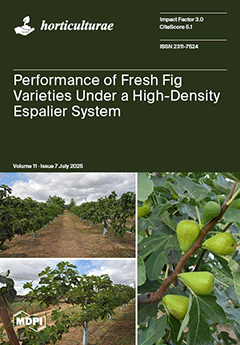The objective of this study was to evaluate the physiological, biochemical, and productive effects of the foliar application of bioregulators, based on auxin, cytokinin, and gibberellic acid, on yellow melon, cultivar DALI
®, plants subjected to different salinity levels in a protected
[...] Read more.
The objective of this study was to evaluate the physiological, biochemical, and productive effects of the foliar application of bioregulators, based on auxin, cytokinin, and gibberellic acid, on yellow melon, cultivar DALI
®, plants subjected to different salinity levels in a protected environment to simulate Brazil’s semi-arid conditions. The experiment was conducted using a completely randomized block design, in a 4 × 3 factorial scheme, with four salinity levels (0, 2, 4, and 6 dS m
−1) and three doses of the bioregulator, Stimulate
® (0%, 100%, and 150% of the recommended dose), with six weekly applications. The physiological variables (chlorophyll
a fluorescence and gas exchange) and biochemical parameters (antioxidant enzyme activity and lipid peroxidation) were evaluated at 28 and 42 days after transplanting, and the agronomic traits (fresh fruit mass, physical attributes, and post-harvest quality) were evaluated at the end of the experiment. The results indicated that salinity impaired the physiological and productive performance of the plants, especially at higher levels (4 and 6 dS m
−1), causing oxidative stress, reduced photosynthesis, and decreased yield. However, the application of the bioregulator at the 100% dose mitigated the effects of salt stress under moderate salinity (2 dS m
−1), promoting higher CO
2 assimilation rates of up to 31.5%, better water-use efficiency, and reduced lipid peroxidation. In addition, the fruits showed a greater mass of up to 66%, thicker pulp, and higher soluble solids (> 10 °Brix) content, making them suitable for sale in the market. The 150% dose did not provide additional benefits and, in some cases, resulted in inhibitory effects. It is concluded that the application of Stimulate
® at the recommended dose is effective in mitigating the effects of moderate salinity, up to ~3 dS m
−1, in yellow melon crops; however, its effectiveness is limited under high salinity conditions, requiring the use of complementary strategies.
Full article





